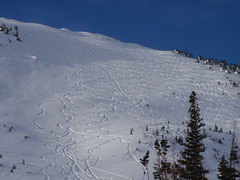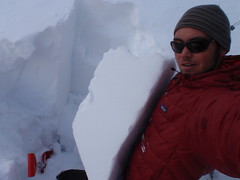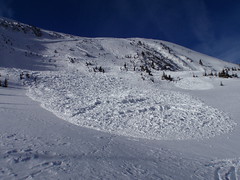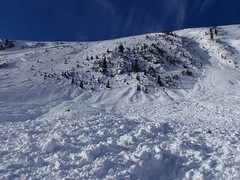“I love the winter mountains, but dread them too, as any sane person should. In a city it’s easy to think of the earth as fragile. Out here it feels otherwise. This place doesn’t seem weak. This earth won’t shatter at our touch. What seems fragile is how we think of ourselves. Out here I feel the immensity that lies beyond thought. In our minds, we make a small, safe place in which to live. But the world is a presence beyond our acts and dreams. There are blue mountains and white storms. We can prepare, but not predict.”
– C.L. Rawlins

Ptarmigan Run saw some action earlier this week.
This past Friday a friend and I scouted out Longest Run and some glades up around American Lakes. Although I didn’t observe any fresh natural activity, the snowpack was extremely tender and reactive. Temperatures remained in the low 20s, but with little wind. Aspects below treeline exposed to sun were especially worrisome and by the end of our day shooting cracks and settling were non-stop. We ended up retreating from both our planned descents. Pits dug on Longest Run (N. facing, below treeline) revealed a thick and fairly hard slab – 75cm of / (Decomposing & Fragmented Particles) and 30cm of + (Precipitation Particles), suspended by 75+ cm of FC (Faceted Crystals) and ^ (Cup-Shaped Crystals – Depth Hoar). An ice lens near the ground was still apparent in some areas. Up near American Lakes we found a shallow and less complex snowpack on NW/W aspects but of the same nature: Slab on a deep layer of facets, a “suspended snowpack”.

The layer of concern.
On Saturday around noon a large chunk of the N/NE face of S. Diamond slid. This is the third year in a row this slope has avalanched. Apparently it was a busy day up there; skiers and riders were farming turns on Ptarmigan Run, kids were hucking jumps at the base of Main Gully, and several parties were traversing the bench below the face. Fortunately no one was caught in the slide. It is still unclear whether the avalanche was natural or remotely triggered by a party skiing along the ridge or down on the bench.

Looking up the slide from the S. end.
I drove up early Sunday morning to examine the scene. I was amazed by the length of propagation: from S. Gully to the center of the face, a couple hundred yards easy. The crown appeared to be between three and seven feet in depth, and the slope slid on a prevalent basal crust. Tongues of debris (10+ feet deep in areas) crossed the bench and petered out in the glades. The rocky steps on S. Shoulder slid as well, though possibly at an earlier date. I dug pits on a similar aspect to the slide and observed a layer of hard slab (95cm in depth – 65 / and 30 cm +) resting on top of 65+ cm of facets, on top of a thin basal crust… Nothing new and pretty universal for these aspects in the zone. I also saw easy results (CT-9 / ECT-14 / Quality 2) with stability tests.

Debris on the bench was 10+ feet deep in areas.
It’s not all doom and gloom though. I found good turns above treeline on the E. face of North Diamond. Though slightly wind/sun affected the snowpack was relatively shallow/consistent and offered up some good carvable turns on a styrofoam-like surface. It’s been a warm week up in the high-country and the wind has died down a bit. Don’t let these calm, sunny conditions fool you. Expect lingering sensitivity for some time to come.
Here’s a quote Ethan Greene of the CAIC posted on the 8th: “We are issuing a Special Advisory Statement for the Northern Mountains and the Sawatch range. Dangerous avalanche conditions currently exist in backcountry areas. A very weak snowpack and weather earlier this season have created conditions where natural avalanches are unlikely, but human triggered avalanches are probable.”
As always, be safe and have fun.
Kevin L.
– There’s some good pics and discussion about the recent slide on Powderbuzz.

